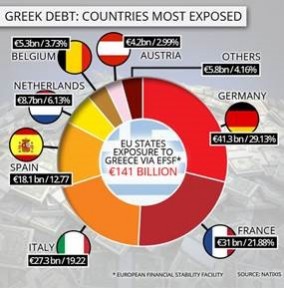The fireworks started early this year. As Americans get ready to celebrate the birth of our democracy, the birthplace of democracy fills the news. Greece may default.
We found it helpful to organize this week’s big story into high spots:
- Greece is unable to pay back a loan due now.
The future of Greek banks?
- Greece will almost certainly default on more loans unless the lenders (mostly European nations) agree to refinance. Greece owes a total of $271 billion. Much of that debt is from past bailouts.

- The lenders have no confidence the Greeks will pay back their debts, and won’t refinance unless Greece commits to austerity.
- On Sunday the Greek people will vote “yes” (for austerity) or “no” (“we’ll take our chances.”)
- If the Greek people vote “yes,” which is what the rest of Europe wants, they will be voting for sacrifice and hardship.
- If they vote “no,” which is what the Prime Minister wants, Greece may have to leave the euro and go back to an old currency called the drachma, which sounds like something out of Game of Thrones and may be even less relevant.
The pessimists believe a “no” vote has scary implications, which is why the markets went down this week.
Note: all of these implications are unlikely and very speculative:
- If Greece defaults, Portugal, Ireland, Italy and Spain may be tempted to do the same. Europe could spiral into a serious economic decline.
- If countries decide they can walk away from the euro, international investors will lose faith in the currency. Money will fly out of Europe, throwing Europe into depression.
Comment: We’ve been through the wringer with Greece four other times in recent memory: May 2010; November 2010; July through December 2011; and May 2012. Same story, different verse?
Remembering the Continental
Talking about the drachma during the week of the 4th reminded of us of the ill-fated currency formed during our American Revolution called “the continental”.
In 1775, the Continental Congress needed centralized money, so they invented (out of thin air) “continental currency”, which most people called “continentals”. During the Revolution, Congress issued $241,552,780 worth of continentals.
Continentals lost value during the war because the British found the money easy to counterfeit. After the war Ben Franklin wrote, “The artists they employed performed so well that immense quantities of these counterfeits which issued from the British government in New York, were circulated among the inhabitants of all the states, before the fraud was detected. This operated significantly in depreciating the whole mass.”
By 1781, continentals had no value.
Comment: A well-known phrase after the war – if something had no value, it was “not worth a continental.”
Fourth of July Fireworks Finance
Not everybody loves fireworks
The American Pyrotechnics Association projects spending on this year’s 4th of July fireworks will exceed $725 million. Of that total, $250 million will be spent by communities, and $500 million by backyard consumers.
Fireworks facts:
- The typical fireworks display costs $1000 per minute.
- Washington DC’s Independence Day fireworks are expected to cost $250,000.
- New York’s fireworks – “the Granddaddy of fireworks displays” will cost $500,000.
- The longest fireworks show in history took place in Norway last year, and lasted 90 minutes.
- The first celebration of Independence Day was in 1777, six years before Americans knew whether or not the new nation would survive the war. Fireworks were a part of the first celebration’s festivities.
- In 1789, George Washington’s inauguration was also accompanied by a fireworks display.
Comment: The Chinese invented fireworks. Most fireworks are still made in China.
The Week Ahead
Economics – Kaitlin Matheson
This Thursday the employment situation, a set of labor market indicators, will be released. The labor market conditions come from two national surveys, the Household survey and the Establishment survey.
The Household survey includes the unemployment rate, labor supply, and discouraged workers among other indicators. The Establishment survey includes nonfarm payroll employment, average workweek, and average hourly earnings along with other indicators. This report can definitely move the markets, and investors are sometimes able to find unique opportunities by noting which sectors in the economy are good investments for their portfolios.
Everyone loves getting paid more for their work. A raise surely puts a smile on your face, and maybe makes you laugh at your boss’s jokes a little longer. However, if wage inflation is rising in the workforce, interest rates will normally rise as well which causes bond and stock prices to drop. The Fed also has less control over monetary policy when wage inflation is increasing.
If the workforce has become more productive, wage inflation might not be present. So if you receive a raise and really feel that you’re more efficient at your job, your wage might not be inflated.
But if your own pride potentially clouds your judgment, take a look at the employment situation report and see for yourself if wage inflation is on the rise.
(Kaitlin is a nationally recognized economics student at Clemson University)
Wednesday: Motor Vehicle Sales and ADP Employment Report
Thursday: Jobless Claims
Friday: Markets Closed
Earnings
Wednesday: Acuity Brands, General Mills, McCormick & Co, Paychex, Constellation Brands
Thursday: International Speedway
Stock Splits
Wednesday: Tsingtao Brewery 2:1